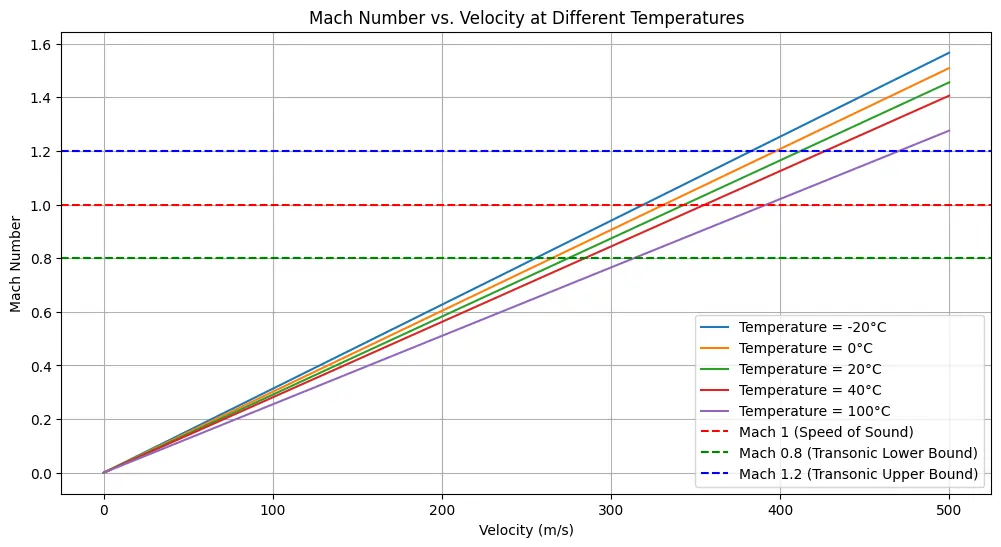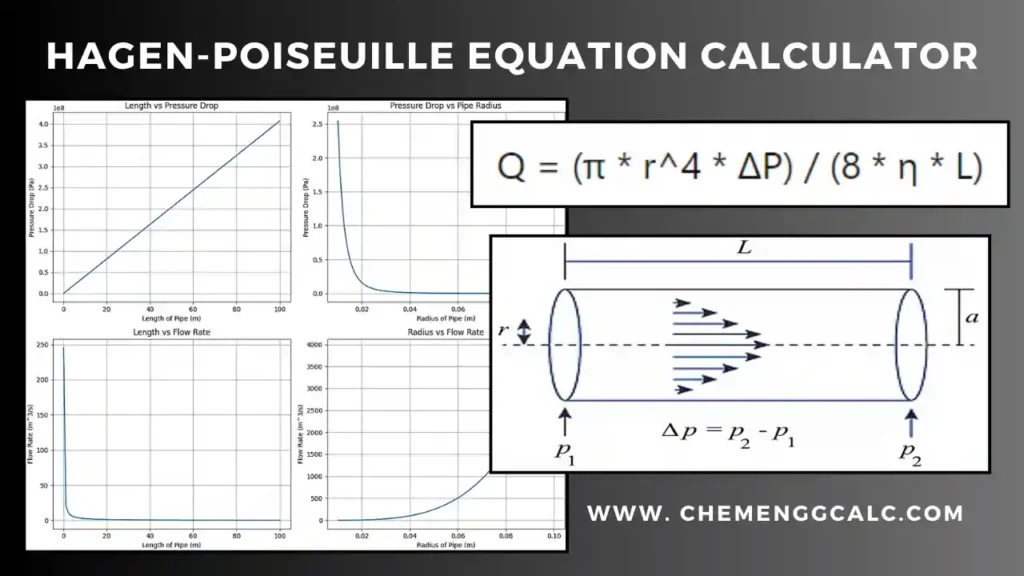Table of Contents
What is Mach Number?
The Mach number (denoted as M or Ma) is a dimensionless quantity in fluid dynamics that represents the ratio of the speed of an object (or the speed of flow) to the speed of sound in the surrounding medium.
The Mach number (M) defined as:
\[ M = \frac{\text{speed of object}}{\text{speed of sound}} \]
\[ M = \frac{u}{c} \]
where:
- \(M\) represents the local Mach number.
- \(u\) is the local flow velocity relative to the boundaries.
- \(c\) is the speed of sound in the medium (e.g., air).
The Ma number is used to classify the speed of an object relative to the speed of sound.
Note: As the temperature increases, the speed of sound also increases. The speed of sound in air at 20°C is approximately 343 m/s.
Related: Newton’s Law of Viscosity Calculator – Dynamic Viscosity
Related: Other Dimensionless Numbers
Mach Number Calculator
This calculator helps user to input the speed of an object and the speed of sound at the required temperature to determine the Mach number. Based on the calculated value of Ma number it classifies the flow as subsonic, sonic, supersonic, or hypersonic.
Related: Hagen-Poiseuille Equation Calculator / Poiseuille’s Law Solver
Related: Hydraulic Diameter Calculator for Circular and Non-Circular cross-section
Significance of the Mach Number
The Ma Number can be classified based on the speed of object relative to the speed of sound. For example the Ma number of 0.85 means the speed of the object is 85% of the speed of the sound.
For Subsonic Flow (Ma < 1) the object travels slower than the speed of sound. eg. Commercial passenger jets, such as the Boeing 737, typically cruise at Mach 0.8.
For Transonic (Ma ≈ 1) the object travel at speed close to the speed of sound, it usually ranges from Mach 0.8 to Mach 1.2. eg. High performance military aircraft and jet fighters.
For Supersonic (1 < Ma < 5) the object travels faster than speed of sound. eg. Concorde, a retired supersonic passenger airliner
For Hypersonic (Ma ≥ 5) the object travels much faster than the speed of sound. e.g the space shuttle during re-entry or hypersonic missiles.
Mach Number Applications
Ma number is used by engineers and scientists to predict the effects of high-speed travel through different mediums, which is used to ensure safety, efficiency, and performance of various vehicles and systems.
- In Meteorology Ma Number is used to understand the weather patterns in atmosphere.
- In Aerospace Engineering for the designing and testing of missiles and spacecraft to ensure efficient performance at various speeds and altitudes.
- Important in the Acoustics study of sound propagation, for objects moving at high speeds, such as supersonic jets.
- For the design and operation of space vehicles that re-enter the Earth’s atmosphere, so that vehicles can manage the thermal and pressure loads experienced at high Ma numbers.
Other Dimensionless Numbers
Here we have tabulated the list of dimensionless numbers which are commonly used in Chemical Engineering with their formula, definition, and significance.
| Dimensionless Number | Formula | Definition | Significance |
|---|---|---|---|
| Reynolds Number (Re) | \[\text{Re} = \frac{\rho u L}{\mu} = \frac{u L}{\nu}\] | Ratio of inertial forces to viscous forces. | Determines flow regime: Re < 2000: Laminar flow Re > 4000: Turbulent flow. Critical for pipe flow and reactors. |
| Prandtl Number (Pr) | \[\text{Pr} = \frac{C_p \mu}{k}\] | Ratio of momentum diffusivity to thermal diffusivity. | It indicates the relative thickness of momentum and thermal boundary layers in heat transfer. |
| Nusselt Number (Nu) | \[\text{Nu} = \frac{h L}{k}\] | Ratio of convective to conductive heat transfer. | It is used in convective heat transfer problems to evaluate heat transfer coefficients. |
| Sherwood Number (Sh) | \[\text{Sh} = \frac{k_m L}{D}\] | Ratio of convective to diffusive mass transfer. | It is important in mass transfer, especially in diffusion and absorption processes. |
| Péclet Number (Pe) | \[\text{Pe} = \text{Re} \cdot \text{Pr}\] | Ratio of advection to diffusion. Combines Reynolds and Prandtl numbers. | It is important in heat and mass transfer processes where advection dominates over diffusion. |
| Schmidt Number (Sc) | \[\text{Sc} = \frac{\mu}{\rho D}\] | Ratio of momentum diffusivity to mass diffusivity. | It is used in mass transfer to relate momentum and mass transport. Analogous to the Prandtl number in heat transfer. |
| Lewis Number (Le) | \[\text{Le} = \frac{\alpha}{D} = \frac{\text{Sc}}{\text{Pr}}\] | Ratio of thermal diffusivity to mass diffusivity. | It relates thermal and mass transport; Le = 1 implies similar thermal and mass diffusivity. |
| Fourier Number (Fo) | \[\text{Fo} = \frac{\alpha t}{L^2}\] | Ratio of heat conduction rate to heat storage rate. | It is used in unsteady-state heat transfer problems, like transient conduction. |
| Biot Number (Bi) | \[\text{Bi} = \frac{h L}{k}\] | Ratio of internal thermal resistance to surface thermal resistance. | It determines whether heat conduction is lumped or distributed. Bi < 0.1: Lumped system approximation valid. |
| Weber Number (We) | \[\text{We} = \frac{\rho u^2 L}{\sigma}\] | Ratio of inertial forces to surface tension forces. | It is important in multiphase flows, droplet formation, and fluid interface stability. |
| Capillary Number (Ca) | \[\text{Ca} = \frac{\mu u}{\sigma}\] | Ratio of viscous forces to surface tension forces. | It is used to study the behavior of capillary flows and thin-film phenomena. |
| Froude Number (Fr) | \[\text{Fr} = \frac{u^2}{g L}\] | Ratio of inertial forces to gravitational forces. | It is important in free-surface flows, mixing, and fluidized bed design. |
| Damköhler Number (Da) | \[\text{Da} = \frac{\text{Reaction rate}}{\text{Flow rate}}\] | Ratio of chemical reaction time to residence time. | It is important in chemical reaction engineering; determines if a process is reaction- or transport-limited. |
| Thiele Modulus (ϕ) | \[\phi = L \sqrt{\frac{k}{D}}\] | Ratio of reaction rate to diffusion rate within a catalyst particle. | It is used in heterogeneous catalysis to determine diffusion limitations within catalyst pores. |
| Knudsen Number (Kn) | \[\text{Kn} = \frac{\lambda}{L}\] | Ratio of molecular mean free path to characteristic length. | It is important in gas flow through small pores or microchannels; indicates continuum vs. molecular flow regime. |
| Eckert Number (Ec) | \[\text{Ec} = \frac{u^2}{C_p \Delta T}\] | Ratio of kinetic energy to enthalpy difference. | It is used in high-speed flows and heat transfer problems involving viscous dissipation. |
| Grashof Number (Gr) | \[\text{Gr} = \frac{g \beta \Delta T L^3}{\nu^2}\] | Ratio of buoyancy forces to viscous forces. | It determines the importance of natural convection in heat transfer problems. |
| Stanton Number (St) | \[\text{St} = \frac{h}{\rho u C_p}\] | Ratio of heat transfer coefficient to the product of fluid velocity and specific heat. | It is used in heat transfer to describe convective heat transfer efficiency relative to bulk flow. |
Related: 10 Mostly used Dimensionless Numbers in Chemical Engineering
Python Code for Mach Number Calculation
This Python code helps user to calculate the Mach number for a range of velocities (0 to 500 m/s) at different temperatures. It plots the Mach number against velocity for each temperature.
Note: This Python code solves the specified problem. Users can copy the code and run it in a suitable Python environment. By adjusting the input parameters, and observe how the output changes accordingly.
import numpy as np
import matplotlib.pyplot as plt
# Function to calculate the speed of sound in air at a given temperature
def speed_of_sound(temperature):
# Speed of sound formula: a = 331.3 + 0.606 * T (T in Celsius)
return 331.3 + 0.606 * temperature
# Function to calculate Mach number
def calculate_mach_number(velocity, speed_of_sound):
return velocity / speed_of_sound
# Define range of velocities (in meters per second)
velocities = np.linspace(0, 2000, 100) # From 0 to 500 m/s
# Define temperatures (in Celsius)
temperatures = [-20, 0, 20, 40, 100] # Example temperatures
# Plot the results
plt.figure(figsize=(10, 6))
for temp in temperatures:
sos = speed_of_sound(temp) # Calculate speed of sound at this temperature
mach_numbers = calculate_mach_number(velocities, sos) # Calculate Mach numbers
plt.plot(velocities, mach_numbers, label=f'Temperature = {temp}°C')
# Add horizontal lines for reference
plt.axhline(y=1, color='r', linestyle='--', label='Mach 1 (Speed of Sound)')
plt.axhline(y=0.8, color='g', linestyle='--', label='Mach 0.8 (Transonic Lower Bound)')
plt.axhline(y=1.2, color='b', linestyle='--', label='Mach 1.2 (Transonic Upper Bound)')
# Add titles and labels
plt.title('Mach Number vs. Velocity at Different Temperatures')
plt.xlabel('Velocity (m/s)')
plt.ylabel('Mach Number')
plt.legend()
plt.grid(True)
# Show plot
plt.show()Output:

Resources
- “Fluid Mechanics” by Frank M. White
- “Introduction to Fluid Mechanics” by Robert W. Fox, Alan T. McDonald, and Philip J. Pritchard
- “Principles of Heat and Mass Transfer” by Frank P. Incropera and David P. DeWitt
- Python.org – The official Python website offers tutorials, documentation, and resources for learning Python.
- Physics Tutorial: The Speed of Sound (physicsclassroom.com)
Disclaimer: The Solver provided here is for educational purposes. While efforts ensure accuracy, results may not always reflect real-world scenarios. Verify results with other sources and consult professionals for critical applications. Contact us for any suggestions or corrections.






